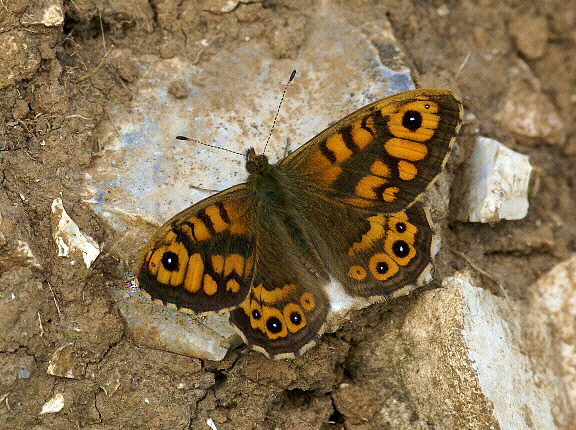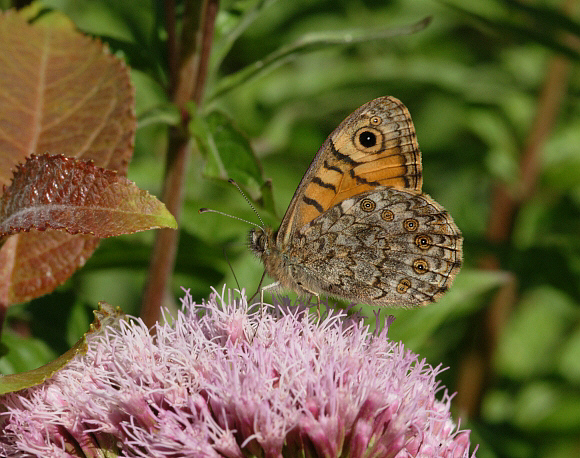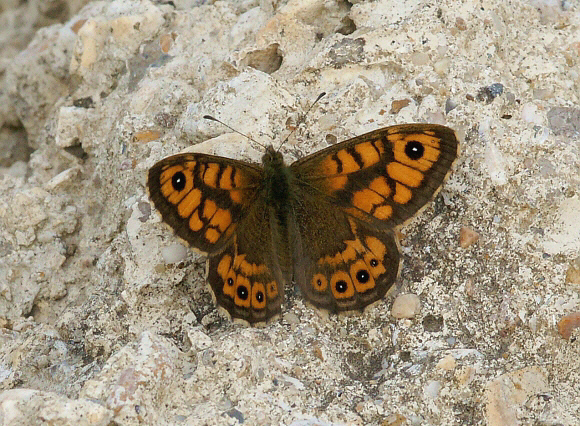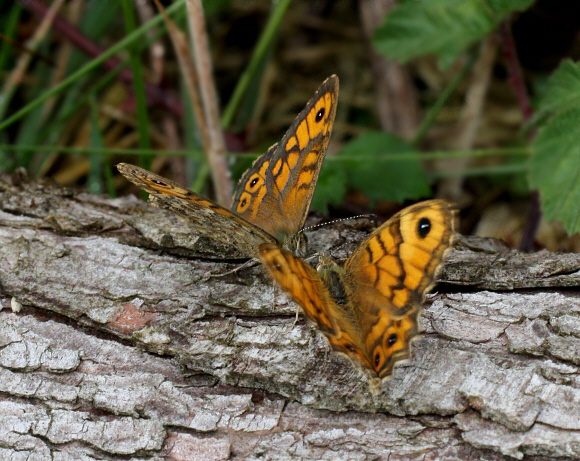 Wall Brown Lasiommata megera, male, Dorset – Adrian Hoskins
Wall Brown Lasiommata megera, male, Dorset – Adrian Hoskins
Introduction
There are 16 Lasiommata species distributed variously across Europe and temperate Asia. Some workers classify Lasiommata as a subgenus of Pararge, which comprises of a further 3 species.
The Wall Brown is found across most of Europe with the exception of northern Britain and northern Scandinavia. It also occurs over much of north Africa, and in temperate regions of western and central Asia.
Habitats
In England and Wales the Wall Brown was formerly more widespread, and occurred in a wide range of habitats. In the latter part of the 20th century it became evident that most of the inland colonies were dying out, and the species was contracting it’s range westward, and towards coastal regions.
At the current time ( 2008 ) the species is restricted largely to sites within about 10-15 miles of the coastline, and is most frequently encountered at coastal habitats : cliff-tops, undercliffs, south-facing grassy slopes, shingle banks, sea walls and sand dunes.
There is some evidence that the butterfly is beginning to regain lost ground, recolonising inland sites e.g. in Dorset, Wiltshire, and in the north of England. The most northerly colonies occur around the coast of southern Scotland.
The reasons for the collapse of inland colonies, and the recent slight recovery, are probably related to climatic changes. The butterfly seems to thrive best when cold and harsh winters are followed by warm dry summers, and to collapse when winters are mild and wet. It clearly needs conditions to be warm and sunny during the flight periods, and even if there is enough warmth for eggs to be laid in reasonable numbers a few days of rain can easily cause them to be washed away. Over 8 months of the lifecycle are spent in the caterpillar stage, and if conditions are mild and wet between September and April, as they have been in recent years, the larvae are more prone to viral attack; and exposed for an extended period to predation and parasitism.
 Wall Brown Lasiommata megera, male, Arnside Knott, Cumbria – Adrian Hoskins
Wall Brown Lasiommata megera, male, Arnside Knott, Cumbria – Adrian Hoskins
All habitats are characterised by having extensive areas of exposed ground in the form of well trodden paths, eroding banks, scree, rabbit scrapes etc.
Colonies tend to be small, comprising no more than about 20 or 30 individuals on the peak day of the flight season, even at the best sites.
 Wall Brown Lasiommata megera, male, Dorset – Adrian Hoskins
Wall Brown Lasiommata megera, male, Dorset – Adrian Hoskins
Lifecycle
The butterflies are double-brooded, the first generation emerging in late April and early May, and the second generation in late July or early August. In exceptionally long and warm summers there may be a partial third brood emerging in October.
The pale greenish-white eggs are laid singly or in clusters of 3 or 4, on the roots of grasses where they overhang into sunny recesses at the edge of eroded ground. Rabbit scrapes, path edges, and crumbling undercliffs are typical situations. I have also seen females laying on grass blades at the base of gorse and bramble bushes on south-facing chalk grassland slopes. The eggs hatch after about 12 days.
The caterpillars feed nocturnally on various grasses including Agrostis tenuis, Agrostis gigantea, Brachypodium sylvaticum, Brachypodium pinnatum, Dactylis glomerata, Deschampsia flexuosa and Holcus lanatus. Summer brood larvae hatch in August and enter hibernation while still quite small. In late February they re-awaken, becoming full grown by late March or early April. The mature larva is pale bluish-green, with whitish stripes along the back and sides.
The pupa is virtually impossible to locate in the wild, and varies in colour from pale green to deep olive and sometimes almost blackish. It has reportedly been found hanging from grass stems around the base of small bushes. The pupal stage lasts for about 2 weeks.
 3rd brood Wall Brown, male, Ouse Estuary, East Sussex – Adrian Hoskins
3rd brood Wall Brown, male, Ouse Estuary, East Sussex – Adrian Hoskins
Adult behaviour
On calm days the butterflies tend to inhabit cliff tops and other high ground, but when it is cooler or windy they seek shelter and warmth at the bottom of hills. They tend to spend long periods settled on bare ground on paths, rabbit scrapes or overhangs. In lightly overcast weather, or during cooler conditions cool early or late in the day, males bask with wings outspread, exposing the maximum wing area to the sun. Another tactic they use is to raise the wings to a 45� angle, which traps pockets of warm air above the thorax and abdomen. These thermoregulatory actions are essential, enabling them to achieve the high body temperatures vital for rapid take-off and interception of potential mates. They intercept all passing butterflies of roughly similar size and colour, including Peacocks, which they chase away from their territories. Smaller butterflies, and those with much brighter colouring such as Orange tips, Large Whites, Clouded Yellows and Brimstones are ignored.
When a male intercepts a female, a short but elaborate courtship ritual takes place, in which the male chases the female until she settles on the ground, and then flies around her, eventually settling in front of her, face to face. The female then responds by quivering her open wings, at which point the male half opens his own wings, and “bows” several times to his prospective mate.

Lasiommata megera, courtship ritual ( male on left ), Alner’s Gorse, Dorset – Adrian Hoskins
In hot conditions Wall Browns close their wings immediately on landing, with the fore-wings raised so that the apical ocellus is visible. This probably acts as a decoy, so that any bird which spots where the butterfly has settled, attacks the false-eye marking, rather than the butterfly’s body. After a moment, when the butterfly is sure it has not been followed, it lowers the forewing to hide the ocellus. This behaviour is common to several other Satyrines including Grayling, Small Heath and Meadow Brown.
Wall browns are at all times extremely alert, and are notoriously difficult to approach. Even in cool conditions they react instantly to the slightest disturbance, rapidly flying up and disappearing over the top of tall bushes. The high energy levels of males cause them to “burn themselves out” very quickly, and thus they are one of the shortest lived British species, with an adult lifespan of only 3 or 4 days. Females, being more sedentary, live longer, averaging about 8-10 days.
The butterflies are notoriously difficult to photograph – I�m well used to playing hide and seek with them – clambering up slopes, peeking over tussocks of grass at basking males, hoping I can press the shutter release before they detect me. It takes more than careful stalking to get the better of a Wall Brown however. One day in May 2008, I spent over 4 hours attempting to photograph various individuals, but each time, although the butterfly was static and composed nicely in the centre of the viewfinder, by the time the shutter had fired it had flown. I took over 20 photographs, but in 18 of them the butterfly was absent from the final image, or caught in flight at the edge of the frame.
Incredible as it seems, Wall Browns are able to detect the sound of the SLR mirror as it flips up, and shoot into flight before the shutter opens. The delay between mirror-up and shutter release is just a few milliseconds, but in that time the butterflies can not only detect the sound and register it as a threat, but can trigger an escape response and take flight, becoming nothing more than a blur at the edge of the image, or leaving the photographer with a photograph of a patch of vacant soil.
Both sexes patrol back and forth along a regular route, often along paths or areas of broken ground, high on hillsides or cliff tops. They go through a regular cycle of patrolling, resting and nectaring.
Favoured nectar sources include buttercups, dandelions and common vetch in spring, while in summer they favour scabious, hawkbit and hemp agrimony.
